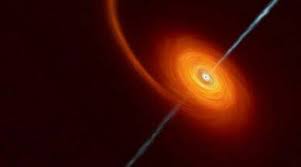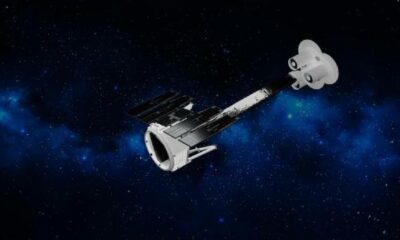The genesis and growth of galaxies and their supermassive black holes are upended by brilliant, extremely red objects previously observed in the early cosmos, according to a recent discovery made by NASA’s James Webb Space Telescope (JWST).
Approximately 600–800 million years after the Big Bang, when the universe was only 5% of its current age, three enigmatic objects were discovered by an international team lead by Penn State researchers using the NIRSpec instrument aboard JWST as part of the RUBIES survey. Today, June 27, they published the discovery in Astrophysical Journal Letters.
The group examined spectral measurements, or the brightness of various light wavelengths that the objects emitted. They discovered evidence of “old” stars in their research that were hundreds of millions of years old—much older than would be predicted in a young universe.
Estimating that the objects are 100–1,000 times more massive than the supermassive black hole in our own Milky Way, the researchers stated they were also taken aback by signs of large supermassive black holes found in the same objects. Current models of supermassive black hole generation and galaxy growth expect galaxies and their black holes to grow together over billions of years of cosmic history, neither of which is predicted by these models.
“We have confirmed that these appear to be packed with ancient stars—hundreds of millions of years old—in a universe that is only 600–800 million years old. Remarkably, these objects hold the record for the earliest signatures of old starlight,” stated Bingjie Wang, the lead author of the work and a postdoctoral scientist at Penn State.
“It was totally unexpected to find old stars in a very young universe. The standard models of cosmology and galaxy formation have been incredibly successful, yet, these luminous objects do not quite fit comfortably into those theories.”
When JWST delivered its first dataset in July 2022, the scientists were able to see the enormous objects for the first time. The objects’ existence was confirmed by the researchers in a study that was published in Nature after several months.
Although they initially thought the objects might be galaxies, the researchers later took spectra to confirm their interpretation and gain a better understanding of the objects’ actual distances and the sources of their enormous luminosity.
Afterwards, using the fresh information, the scientists were able to create a more precise image of the galaxies’ appearance and contents. The group discovered evidence of very huge supermassive black holes and an unexpectedly old population of stars in addition to confirming that the objects were, in fact, galaxies close to the beginning of time.
Joel Leja, an assistant professor of astronomy and astrophysics at Penn State and a co-author of both publications, described the situation as “You can make this uncomfortably fit in our current model of the universe, but only if we evoke some exotic, insanely rapid formation at the beginning of time. This is, without a doubt, the most peculiar and interesting set of objects I’ve seen in my career.”
The JWST has infrared sensing sensors that can pick up light from even the oldest stars and galaxies around. According to Leja, the telescope basically lets scientists sight back in time to a point about 13.5 billion years ago, or close to the beginning of the universe as we know it.
Differentiating between the various kinds of items that could have emitted the light can be a challenge when analyzing ancient light. These early objects exhibit traits that are distinctly similar to both supermassive black holes and ancient stars.
Wang clarified that the amount of light observed from each source is still unknown, so these could be either more normal-mass galaxies with “overmassive” black holes, which are roughly 100–1,000 times more massive than a galaxy would have today, or they could be unexpectedly old and massive galaxies that formed much earlier than models predict.
“Distinguishing between light from material falling into a black hole and light emitted from stars in these tiny, distant objects is challenging,” Wang stated. “That inability to tell the difference in the current dataset leaves ample room for interpretation of these intriguing objects. Honestly, it’s thrilling to have so much of this mystery left to figure out.”
If some of the light originates from supermassive black holes, then in addition to their unexplained mass and age, they are also not your typical supermassive black holes. They emit significantly more ultraviolet photons than anticipated, and comparable objects observed with other sensors do not exhibit the typical indications of supermassive black holes, like intense X-ray emission and heated dust. The researchers speculated that their apparent size may be the most unexpected finding.
“Normally supermassive black holes are paired with galaxies,” Leja stated. “They grow up together and go through all their major life experiences together. But here, we have a fully formed adult black hole living inside of what should be a baby galaxy. That doesn’t really make sense, because these things should grow together, or at least that’s what we thought.”
The fact that these systems were only a few hundred light years across—roughly 1,000 times smaller than our own Milky Way—confounded the astronomers as well. With between 10 billion and 1 trillion stars, the number of stars is almost the same as that of our own Milky Way galaxy, yet they are contained in a volume 1,000 times smaller than that of the Milky Way.
Leja clarified that the closest star would be nearly within our solar system if the Milky Way were compressed to the size of the galaxies they discovered. Only roughly 26 light years would separate Earth and the supermassive black hole at the center of the Milky Way, which is located roughly 26,000 light years away, from Earth. It would appear as a gigantic pillar of light in the sky.
Further observations, according to the experts, may be able to shed light on some of the objects’ riddles. By directing the telescope at the objects for extended periods of time, they hope to obtain deeper spectra. By recognizing the distinct absorption signatures that would be present in each, this will assist detangle emission from stars and the possible supermassive black hole.
“There’s another way that we could have a breakthrough, and that’s just the right idea,” Leja stated. “We have all these puzzle pieces and they only fit if we ignore the fact that some of them are breaking. This problem is amenable to a stroke of genius that has so far eluded us, all of our collaborators and the entire scientific community.”s Given how enormous they appear to be.

 Entertainment4 weeks ago
Entertainment4 weeks ago
 Entertainment4 weeks ago
Entertainment4 weeks ago
 Entertainment4 weeks ago
Entertainment4 weeks ago
 Entertainment4 weeks ago
Entertainment4 weeks ago
 Entertainment2 weeks ago
Entertainment2 weeks ago
 Entertainment2 weeks ago
Entertainment2 weeks ago
 Entertainment2 weeks ago
Entertainment2 weeks ago
 Entertainment2 weeks ago
Entertainment2 weeks ago







